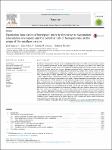Equination (inoculation of horsepox): An early alternative to vaccination (inoculation of cowpox) and the potential role of horsepox virus in the origin of the smallpox vaccine
Esparza, José
Schrick, Livia
Damaso, Clarissa R.
Nitsche, Andreas
For almost 150 years after Edward Jenner had published the “Inquiry” in 1798, it was generally assumed that the cowpox virus was the vaccine against smallpox. It was not until 1939 when it was shown that vaccinia, the smallpox vaccine virus, was serologically related but different from the cowpox virus. In the absence of a known natural host, vaccinia has been considered to be a laboratory virus that may have originated from mutational or recombinational events involving cowpox virus, variola viruses or some unknown ancestral Orthopoxvirus. A favorite candidate for a vaccinia ancestor has been the horsepox virus. Edward Jenner himself suspected that cowpox derived from horsepox and he also believed that “matter” obtained from either disease could be used as preventative of smallpox. During the 19th century, inoculation with cowpox (vaccination) was used in Europe alongside with inoculation with horsepox (equination) to prevent smallpox. Vaccine-manufacturing practices during the 19th century may have resulted in the use of virus mixtures, leading to different genetic modifications that resulted in present-day vaccinia strains. Horsepox, a disease previously reported only in Europe, has been disappearing on that continent since the beginning of the 20th century and now seems to have become extinct, although the virus perhaps remains circulating in an unknown reservoir. Genomic sequencing of a horsepox virus isolated in Mongolia in 1976 indicated that, while closely related to vaccinia, this horsepox virus contained additional, potentially ancestral sequences absent in vaccinia. Recent genetic analyses of extant vaccinia viruses have revealed that some strains contain ancestral horsepox virus genes or are phylogenetically related to horsepox virus. We have recently reported that a commercially produced smallpox vaccine, manufactured in the United States in 1902, is genetically highly similar to horsepox virus, providing a missing link in this 200-year-old mystery.
Dateien zu dieser Publikation
Keine Lizenzangabe

